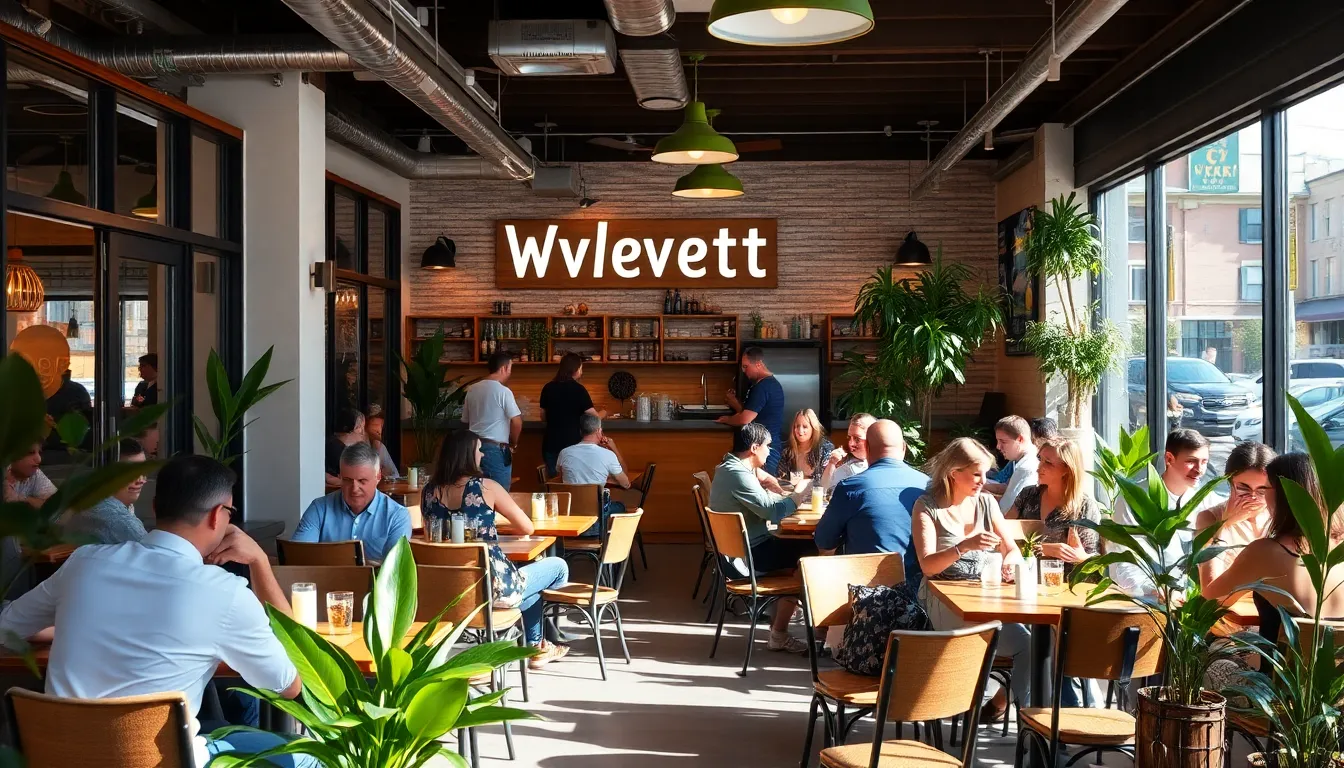Fast casual dining has taken the food world by storm, blending the convenience of fast food with the quality of casual dining. Imagine sinking your teeth into a gourmet burger or a fresh salad without the waitstaff drama or white tablecloths. It’s like having your cake and eating it too—without the guilt of drive-thru fries!
Overview of Fast Casual Dining
Fast casual dining stands as a distinct category in the food industry, merging the speed of fast food with higher-quality ingredients typical of casual dining establishments. Diners appreciate customizable menus featuring gourmet options like artisanal burgers and vibrant salads created from fresh produce.
Operations in fast casual restaurants often focus on creating an inviting atmosphere while streamlining the ordering process, balancing efficiency with a welcoming environment. Customers typically order at the counter and receive their meals in a matter of minutes, eliminating the need for traditional table service.
With a commitment to ingredient quality, fast casual venues often prioritize locally sourced and sustainable products. Many establishments boast transparency about their food preparation, enhancing consumer trust.
The target demographic largely includes millennials and Generation Z, who favor healthy choices and fast service without compromising on flavor or quality. According to market research, the fast casual dining sector has grown significantly, with an increase in annual revenue reaching approximately $45 billion in the United States as of 2023.
Expect an evolving landscape in fast casual dining, driven by dietary preferences such as plant-based options and globally inspired flavors. Investors continue to take interest in this sector, recognizing its potential for innovation and profitability. Various chains from Chipotle to Panera Bread illustrate the diverse offerings within this category, showcasing how fast casual dining addresses modern consumer demands.
Key Characteristics of Fast Casual Dining

Fast casual dining combines the best aspects of quick service and quality cuisine. This hybrid model attracts a diverse clientele by emphasizing both food quality and dining experience.
Quality of Food
Food quality stands out in fast casual dining. Many establishments prioritize fresh ingredients, utilizing locally sourced produce and meats. Gourmet options include customizable salads, artisanal sandwiches, and hand-crafted pizzas. Higher standards of food preparation enhance flavor without compromising on health. Data indicates that the fast casual sector has led to a significant increase in demand for healthier meals. A focus on transparency in sourcing and preparation builds consumer trust. Trends show that guests appreciate knowing the origins of their meals.
Dining Experience
Dining experiences in fast casual venues differ from traditional restaurants. Customers typically order at the counter, significantly reducing wait times. Ambiance plays a vital role, often featuring stylish décor and inviting settings. Social spaces for gathering encourage a sense of community among diners. Options for outdoor seating further enhance the experience during pleasant weather. Fast casual locations also cater to dietary preferences with ease, ranging from vegan to gluten-free options. Data from 2023 reveals the target audience primarily includes millennials and Generation Z, who value effective service paired with quality food.
Popular Fast Casual Dining Chains
Fast casual dining chains play a significant role in the evolving food industry. They cater to a growing demand for quality meals at a quicker pace.
Chain Profiles
Chipotle, known for its customizable burritos and tacos, emphasizes fresh ingredients. Panera Bread provides a variety of sandwiches and soups in a warm, inviting atmosphere. Sweetgreen specializes in salads made from locally sourced produce. MOD Pizza offers personalized pizzas with diverse toppings, appealing to many dietary preferences. Shake Shack focuses on gourmet burgers and shakes, attracting a loyal customer base. These chains exemplify the rise of fast casual concepts, prioritizing quality and customer experience.
Menu Offerings
Menu offerings in fast casual dining chains often reflect health-conscious trends. Burger chains may feature grass-fed meat and plant-based alternatives. Salad restaurants usually allow customers to create their own bowls, selecting from various vegetables and dressings. Sandwich shops commonly offer artisanal breads and locally sourced ingredients. Desserts in these establishments can range from gourmet cookies to seasonal pastries. This variety ensures a satisfying experience that appeals to millennials and Generation Z, who appreciate fresh, flavorful options.
Benefits of Fast Casual Dining
Fast casual dining offers several advantages, attracting customers who seek quality meals without compromising time. Elevated experiences and healthy choices dominate this restaurant segment.
Healthier Options
Health-conscious consumers prefer fast casual dining for diverse, nutritious offerings. Many establishments focus on fresh ingredients, providing salads, grains, and proteins tailored to individual dietary needs. Restaurants like Sweetgreen emphasize locally sourced produce, while burger chains often feature grass-fed meat and plant-based alternatives. Customization options allow customers to create meals that adhere to personal health goals. Transparency in ingredient sourcing boosts consumer trust, making diners more confident in their choices.
Flexible Dining Hours
Flexible dining hours provide convenient options for busy lifestyles. Fast casual venues often open early and close late, accommodating breakfast, lunch, and dinner needs. This accessibility attracts professionals and families alike, fitting seamlessly into varied schedules. Quick service allows for easy takeout, making it simple for customers to enjoy a quality meal on the go. Choices from popular chains like Panera Bread and MOD Pizza ensure diners can find satisfying options no matter the time of day.
Challenges Facing Fast Casual Dining
Fast casual dining faces several challenges impacting growth and sustainability. Understanding these challenges is essential for navigating the competitive landscape.
Competition with Quick Service Restaurants
In the fast casual segment, competition with quick service restaurants intensifies. Quick service establishments often offer similar menu items at lower prices, attracting budget-conscious consumers. These restaurants emphasize speed and convenience, appealing to customers seeking efficiency. Innovations in technology, such as mobile ordering apps, further enhance the appeal of quick service options. Fast casual dining establishments must differentiate themselves by emphasizing ingredient quality and unique culinary experiences. Chains that successfully highlight their gourmet offerings and customization options can mitigate competitive pressures. Continued focus on branding and customer engagement remains vital for retaining loyal patrons in this fiercely competitive market.
Economic Factors
Economic fluctuations significantly impact the fast casual dining sector. Rising food costs affect the pricing strategies of many establishments. Increased labor costs create additional pressures, as wages and operational expenses continue to rise. Inflation can lead consumers to prioritize budget dining options, causing a decline in discretionary spending. Economic downturns particularly influence consumer dining habits, pushing some patrons toward lower-cost alternatives. Chains can adapt by offering value-driven meals that appeal to cost-sensitive customers. Marketers must remain agile, adjusting promotions and pricing to align with changing economic conditions. Finding ways to sustain growth amid various economic challenges is essential for long-term success in this dining category.
Fast casual dining is reshaping the culinary landscape by blending quality with convenience. As it continues to grow in popularity among younger generations, the focus on fresh ingredients and customizable options remains a key attraction. This sector not only meets the demand for healthier meals but also fosters a welcoming environment that encourages community engagement.
While challenges like competition and rising costs persist, fast casual restaurants can thrive by emphasizing their unique offerings and commitment to quality. The future looks bright for this dining trend as it adapts to evolving consumer preferences and culinary innovations.





